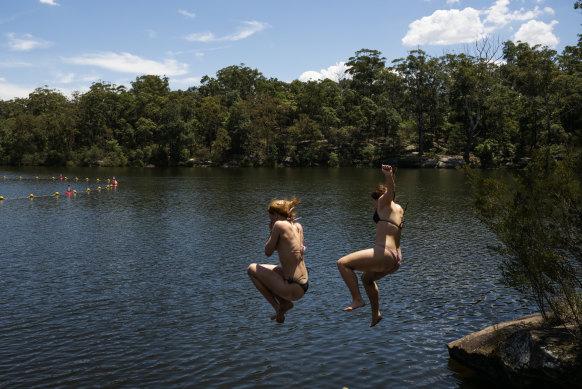
“Unfortunately, it’s getting warmer globally every year so we are going to see more heatwaves,” McAnulty said, speaking at a press conference on Tuesday.
“We’re going to see more hot days ahead. It’s a good reminder before we even get into summer that people need to look after themselves, take heat very seriously and look after their communities.”
He said people could prepare their houses by keeping the doors and windows closed to keep hot air out and drawing blinds or curtains so the sun could not directly heat rooms.
He advised putting on air conditioning or travelling to an air-conditioned space such as a library or shopping centre before weather got too hot.
McAnulty advised people to drink plenty of water, use wet towels or spray or take cold showers. Swimming could be a good way to cool down, he said, as long as appropriate sun protection was used.
NSW Ambulance acting superintendent Christie Marks said if people experienced dizziness, thirst or headaches, they should stay hydrated and try to keep cool. If symptoms were more serious, such as seizures or confusion, they should seek medical assistance or call triple zero.
In the 2020 spring heatwave, most Greater Sydney sites outside the Blue Mountains were near or above 40 degrees on November 28 and 29.

Swimmers take a leap at Lake Parramatta on Tuesday.Credit: Louise Kennerley
Sydney Observatory Hill topped 40 degrees for two consecutive days in November 2020 – the first time since January 1960.
A Bureau of Meteorology spokesperson said forecast maximums for Sydney on Tuesday and Wednesday were similar to the 2020 heatwave, but it was less severe in the rest of the state.
The difference in temperature between the eastern city and western Sydney was up to 10 degrees on Tuesday, the weather bureau said, adding this was not unusual because of sea breezes cooling areas near the coast.
In November 2014, Richmond in the north-west recorded a temperature of 45.3 degrees, while Observatory Hill was 30.1 degrees.
Professor David Karoly from the Climate Council said Penrith topped 40 degrees in November about one day every two years on average, while Parramatta and Richmond topped 40 degrees in November about one day every three years on average, based on figures from the weather bureau.
Lake Parramatta opened for swimming in late October after the state government funded a $1.4 million upgrade, but Penrith Beach or “Pondi” is still closed with construction.
NSW Minister for Planning and Public Spaces Paul Scully said Penrith Beach, which is owned privately, opened for the first time last year and attracted 200,000 visitors over the summer.
Loading
“In our most recent budget we committed $2.5 million to reopen the beach for the 24/25 summer … and upgrades and maintenance to the amenities and beach facilities are being finalised,” Scully said.
Western Sydney Leadership Dialogue chief executive Adam Leto said Penrith Beach should be made permanent and year round.
Leto said western Sydney needed a big investment in increasing the tree canopy to 30 per cent, improving public transport and building bus shelters.
“If there are no direct bus routes, and families need to walk their kids two or three kilometres to get to their bus stop, which is unsheltered, to take their kids to school on a 40-plus degree day, they’re not going [to school],” Leto said.
Get to the heart of what’s happening with climate change and the environment. Sign up for our fortnightly Environment newsletter.



























